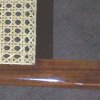Documenting 2 open gunnel Morris canoes. 1910 heart shape 17ft does not have any hardware, so I have no record. Pictured is the 1917 24'' deck 17ft, which has a random carriage bolts and round head slotted bolts with washers. What is the correct bolt head, lenght, diameter for thwarts/seats on open gunnel? I can only guess that this hardware is perhaps not original, or was interchanged when seats/thwarts were removed and replaced during it's life. Most likely inner and outer gunnels will be replaced, but that will be determined positively once the awful paint is stripped.
I've seen bolts in the archive for closed gunnel, but not for open gunnel.
Interested to know if Morris period bolts have modern equivalents and what goes where?


I've seen bolts in the archive for closed gunnel, but not for open gunnel.
Interested to know if Morris period bolts have modern equivalents and what goes where?










